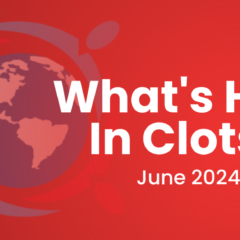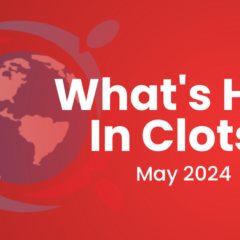Last updated on
What’s Hot in Clots – August 2023
Key Updates in Thrombosis
Table of Contents
- Venous thrombosis with midline catheters: Those with smaller diameters may be safer
- Fibrinolysis for older adults with STEMI: Does cutting the dose cut the risk of intracranial hemorrhage?
- Pitavastatin in patients with HIV receiving antiretroviral therapy
- Not all DVTs are created equal: The gradient of risk
In preparing my reviews for this month, I just realized that it has been a year since I started sharing these article summaries. I hope you have found them interesting!
Here are my picks for this month:
Venous thrombosis with midline catheters: Those with smaller diameters may be safer
A single-institution observational study suggested that use of midline catheters that had 5-mm diameter (instead of 3 mm or 4 mm) or a catheter to vein ratio >1:3 were associated with excess risk of upper extremity venous thrombosis related to midline catheters. Read more.
Fibrinolysis for older adults with STEMI: Does cutting the dose cut the risk of intracranial hemorrhage?
In an RCT of elderly patients (mean age 70.5 years), half-dose tenecteplase led to relatively similar ST-segment resolution and clinical outcomes, compared with primary percutaneous intervention (pPCI). However, tenecteplase, even at this lower dose, was associated with intracranial bleeds in 1.5% of participants (zero with pPCI). Read more.
Pitavastatin in patients with HIV receiving antiretroviral therapy
In a randomized trial of patients with HIV receiving antiretroviral therapy who had low-to-moderate risk of cardiovascular disease, pitavastatin (4 mg daily) was compared with placebo. This particular statin was chosen since it does not interact with many of the commonly used antiretroviral drugs. The study showed that pitavastatin led to a remarkable 35% relative risk reduction for cardiovascular events. Although muscle-related adverse events were relatively more common with pitavastatin, severe rhabdomyolysis was not more common with pitavastatin. Read more.
Not all DVTs are created equal: The gradient of risk
Several prior studies suggested that distal DVT may have less ominous outcomes compared with proximal DVT, as I had covered in this blog last year. Now, a recent investigation suggests that the risk may be even more nuanced in cases of cancer-associated DVT. Cancer-associated distal DVT carries almost as bad of a prognostic significance as that of proximal DVT with respect to risk of subsequent recurrent venous thrombosis or death. However, pulmonary embolism-related mortality seems lower with cancer-associated distal vs proximal DVT. Read more.
For more updates, be sure to subscribe to get the latest updates each month.
Find this information helpful? Please consider making a small donation in support of thrombosis education & resources.

Behnood Bikdeli, MD, MS
Cardiologist, Section of Vascular Medicine, Division of Cardiovascular Medicine, Brigham and Women’s Hospital
Investigator, Thrombosis Research Group, Division of Cardiovascular Medicine, Brigham and Women’s Hospital
Instructor, Harvard Medical School
Investigator, Yale/ YNHH Center for Outcomes Research and Evaluation, Yale School of Medicine
Investigator, Cardiovascular Research Foundation



